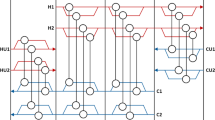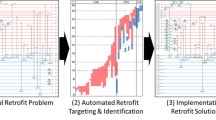Abstract
This paper presents a new synthesis method for retrofitting heat exchanger networks using a two-step procedure. In the first step, the problem data for the network to be retrofitted is extracted and solved for a grass-root scenario using the stage-wise superstructure synthesis method. The matches selected in the solution of this first step, together with the existing units in the original network, constitute the candidate matches used to initialise a reduced superstructure in the second step. These initialising matches are the binary variables of the model, which is solved as a mixed integer non-linear model. The reduced superstructure is systematically initialised considering the sizes of the existing units as a guide. This is done so as to ensure that the heat transfer areas of the existing units are utilised as much as possible before making additional investment. One of the key benefits of this new synthesis approach for retrofitting heat exchanger networks is that the resulting reduced superstructure is relatively computationally less intensive to solve. The proposed method of this paper has been applied to two examples from the literature and the solutions obtained compare well with existing solutions.











Similar content being viewed by others
References
Akpomiemie MO, Smith R (2017) Cost-effective strategy for heat exchanger network retrofit. Energy, https://doi.org/10.1016/j.energy.2017.09.005 146:82–97
Akpomiemie MO, Smith R (2015) Retrofit of heat exchanger networks without topology modifications and additional heat transfer area. Appl Energy 159:381–390
Ayotte-Sauvé E, Ashrafi O, Bédard S, Rohani N (2017) Optimal retrofit of heat exchanger networks: a stepwise approach. Comput Chem Eng 106:243–268
Briones V, Kokossis AC (1999) Hypertargets: a conceptual programming approach for the optimisation of industrial heat exchanger networks – II. Chem Eng Sci 54:541–561
Bogataj M, Kravanja Z (2012) An alternative strategy for global optimization of heat exchanger. Appl Therm Eng 23:75–90
Chen L (2008) Heat-integrated crude oil distillation system design. In: PhD thesis. The University of Manchester, UK
Gadalla M, Jobson M, Smith R (2003) Optimization of existing heat-integrated refinery distillation systems. Transactions of the IChemE 81:147–152
Isafiade A, Bogataj M, Fraser D, Kravanja Z (2015) Optimal synthesis of heat exchange networks for multi-period operations involving single and multiple utilities. Chem Eng Sci 127:175–188
Kang L, Liu Y (2014) Retrofit of heat exchanger networks for multiperiod operations by matching heat transfer areas in reverse order. Ind Eng Chem Res 53:4792–4804
Kralj AK (2010) Optimization of an industrial retrofitted heat exchanger network, using a stage-wise model. Energy 35(12):4748–4753
Li B-H, Chang C-T (2017) Retrofitting industrial heat exchanger network based on pinch analysis. 6th Intrenational Symposium on Advanced Control of Industrial Processes (AdCONIP):469–474. https://doi.org/10.1109/ADCONIP.2017.7983826
Liu X-W, Luo X, Ma H-G (2014) Retrofit of heat exchanger networks by a hybrid genetic algorithm with the full application of existing heat exchangers and structures. Ind Eng Chem Res 53(38):14712–14720
Ma K-L, Hui C-W, Yee TF (2000) Constant approach temperature model for HEN retrofit. Appl Therm Eng 20:1505–1533
Ochoa-Estopier LM, Jobson M, Chen L, Rodríguez-Forero CA (2015) Optimisation of heat-integrated crude oil distillation systems. Part II: heat exchanger network retrofit model. Ind Eng Chem Res 54:5001–5017. https://doi.org/10.1021/ie503804u
Paterson WR (1984) Shorter communication: a replacement for the logarithmic mean. Chem Eng Sci 39(11):1635–1636
Rezaei E, Shafiei S (2009) Heat exchanger networks retrofit by coupling genetic algorithm with NLP and ILP methods. Comput Chem Eng 33(9):1451–1459
Rosenthal RE (2012) GAMS—a user’s guide. GAMS Development Corporation, Washington, DC, USA
Smith R, Jobson M, Chen L (2010) Recent development in the retrofit of heat exchanger networks. Appl Therm Eng 30:2281–2289
Sreepathi, B.K.; Rangaiah, G.P., 2015, Retrofitting of heat exchanger networks involving streams with variable heat capacity: an application of single and multi-objective optimisation, Appl Therm Eng, 75, pg 677–684
Sreepathi BK, Rangaiah GP (2014a) Review of heat exchanger network retrofitting methodologies and their applications. Ind Eng Chem Res 53(28):11205–11220
Sreepathi BK, Rangaiah GP (2014b) Improved heat exchanger network retrofitting using exchanger reassignment strategies and multi-objective optimization. Energy 67:584–594
Tjoe TN, Linnhoff B (1986) Using pinch technology for process retrofit. Chemical Engineering 93(8):47–60
Wang Y, Pan M, Bulatov I, Smith R, Kim J-K (2012) Application of intensified heat transfer for the retrofit of heat exchanger network. Appl Energy 89:45–59
Yee TF, Grossmann IE (1990) Simultaneous optimization models for heat integration—II. Heat exchanger network synthesis. Comput Chem Eng 14(10):1165–1184
Zhang H, Rangaiah GP (2013) One-step approach for heat exchanger network retrofitting using integrated differential evolution. Comput Chem Eng 50:92–104
Funding
This study is supported by the National Research Foundation of South Africa (Grant number: 85536) and the Research Office of the University of Cape Town, South Africa. The funds are gratefully acknowledged.
Author information
Authors and Affiliations
Corresponding author
Ethics declarations
Conflict of Interest
On behalf of all authors, the corresponding author states that there is no conflict of interest.
Appendix
Appendix
The traditional SWS model equations (see Yee and Grossmann, 1990, for details) adopted in modelling the superstructure, are shown below.
Overall enthalpy balance for hot and cold process streams
where HP represents set of hot process streams and hot utilities; CP represents set of cold process streams and cold utilities. \( {T}_{\mathrm{i}}^{\mathrm{s}} \) and \( {T}_{\mathrm{i}}^{\mathrm{t}} \) are the supply and target temperatures of hot streams, while \( {T}_{\mathrm{j}}^{\mathrm{s}} \) and \( {T}_{\mathrm{j}}^{\mathrm{t}} \) are supply and target temperatures of cold streams. Fi and Fj are heat capacity flowrates of hot and cold streams. qi, j, k is quantity of heat exchanged between hot stream i and cold stream j in interval k of thee superstructure.
Stage enthalpy balance for hot and cold streams, respectively:
where ti, k represents hot stream intermediate temperature along the superstructure, while tj, k represents cold stream intermediate temperature along the superstructure.
Temperature feasibility along superstructure interval
Logical constraint:
where Ωp represents maximum heat load that can be formulated as the minimum of the available heat in each of the two streams participating in a match. yi, j, k represents the binary variable in the SWS model of the grass-root solution.
Hot end (dti, j, k) and cold end (dti, j, k + 1) exchanger approach temperatures for calculation of heat exchanger area:
where ϕ is a specified value that the approach temperature would be if no match exists between hot stream i and cold stream j, which implies that the binary variable yi, j, k will be 0.
EMAT calculation:
Paterson (1984) approximation of the logarithmic mean temperature difference:
Rights and permissions
About this article
Cite this article
Isafiade, A.J. Heat Exchanger Network Retrofit Using the Reduced Superstructure Synthesis Approach. Process Integr Optim Sustain 2, 205–219 (2018). https://doi.org/10.1007/s41660-018-0046-1
Received:
Revised:
Accepted:
Published:
Issue Date:
DOI: https://doi.org/10.1007/s41660-018-0046-1




